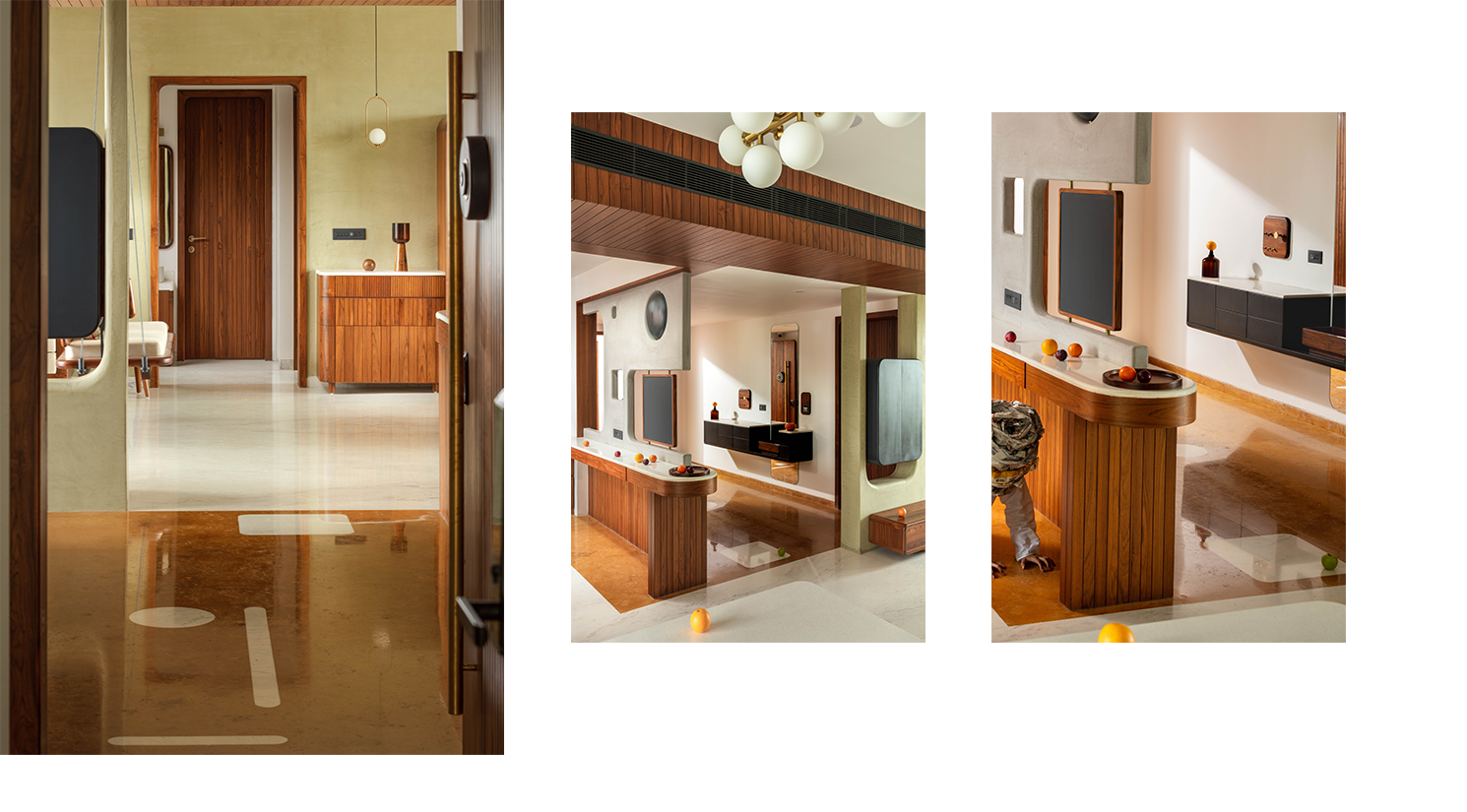
Photography: Dhrupad Shukla Project
Co-ordination : Design Ni Dukaan and team
Furniture : Design Ni Dukaan
Art and Artists : Suneet Wadke, Srijan Jha, Richa Kashelkar
Artefacts : Dotto : Objects of Curiosity, Act Of Quad products, Muselab, lndrajit Satbhai
Wall Finishes : Limocoat
In the client's words, "this house will play a ma1or contribution to my 20-month-old son's growing up': The humble genuineness of this very basic parental concern attracted us to this 2000 sq. ft home for a family of three in Baner, Pune. There was a myriad of other requirements laid out by the client. However, as we progressed, we kept coming back to the "common man's" endearing and rational concern for his child and chose to manifest it in the choice of our concept, space planning, materiality, and photoshoot.

Shibusa (渋さ) refers to simple, subtle, and unobtrusive beauty in affinity with Japanese aesthetics and ideal human behavior. The concept is so deeply ingrained in our daily lives that scholars consider it too commonsensical for serious (scholarly) use. Therefore, we chose it as the premise for the playful cu ration of spaces. We did our best to design a home with simple, honest materials and textures and cater to the family's efficient and functional lifestyle. The absence of walls in the common areas create a wholesome and visually connected overall. It encourages the user to interact with the surroundings based on their need and not the designated use of the room. Shibusa comprises of seven elements: Simplicity, Implicitness, Modesty, Silence, Naturalness, Roughness and Normalcy. Simplicity, Modesty and Roughness are aspects incorporated in the choice of materials and textures. There lies a quiet beauty of an unpretentiousness in our selection that does not assert its presence through striking design or bright colors. Overall, we have attempted to create a very original language that continues in the whole house yet varies in small nuances as you move around the house to create an identity for each space.


The Shibusa element of Implicitness works together with simplicity. In simplicity, there is always an implicit complexity that imbues the deeper meanings. Following this notion, we attempted to celebrate the simplicity of underappreciated moments in our design. For example, in the flooring, the act of crossing the threshold to come home has a playful hopscotch pattern in the foyer and the spot where a person stands to cook rotis in the kitchen has a dignified yellow circle.




We tried to reinvent how we have seen age-old materials for a modern Indian home in a market with a plethora of new materials for superficial treatments. Wood, brass, cane, lime plaster, concrete, stone, fluted glass are a few materials that we used for the project based on their earthiness and imperfectly perfect attributes.




The kitchen allows for cooking and serves as a quick dining nook, while the dining multifunctions as an eating and a working space. Lounging is not limited to the living room but also in the bedrooms for a more intimate, relaxed moment.





When it came to documenting the house, we wanted to stay true to our concept and our belief as a studio. An over-stylized and synthetic shoot was neither the photographer's artistic approach nor ours, so we brainstormed to build a storyline with unique characters. The solution for a non-typical shoot was ironically to do it in an ordinary way - the Shibusa Normalcy way. As an ode to the infamous film on architecture school by Arundhati Roy "in which Annie gives it those ones," we decided to use fruits to give a sense of scale. In the film, Annie, an architecture student struggling to finish school, comes up with an idea to put two water jets on the sides of each train in India. The result is thousands of kilometers of fruit trees along the railway lines all over the country. In the movie, he fondly says, "Phal, phal ke ped," and we fondly call our unorthodox shoot the "Aam aadmi shoot." There was no cutlery on the table, overly done bed sheets, or fake plants or artifacts; we wanted only to capture what we had created with some playful fruits in the frame. The only Shibusa element to touch upon in our wholesome design approach was Silence. According to the Japanese explanation, Silence is the ideal of understatement wherein saying nothing, everything 1s meant. To portray this meaning, we developed a character wearing an understated white color and a mask made from what we consider nothing - discarded newspaper. We let this character move through the house, highlighting the implied aspects of our design through unconventional poses. Our capture of the character mid-air while jumping screams of an electrically charged silent moment - one that gives you goosebumps and leaves you with an enigmatic peace. It essentially summed up our project for its true story - a humble, nurturing home to contain all the energy, fun, playfulness of an ordinary man's family of three.